|
|
|
Sort Order |
|
|
|
Items / Page
|
|
|
|
|
|
|
| Srl | Item |
| 1 |
ID:
156589
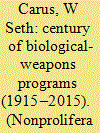

|
|
|
|
|
| Summary/Abstract |
This article reviews what is known about the proliferation of biological-weapon programs during the past century. Collecting information on biological-weapon programs is difficult, even for intelligence organizations, and there is limited information available on the extent and character of past programs. A review of the open-source literature supports claims that twenty-three states had, probably had, or possibly had a program. The number of active programs has varied over time, from a low of zero in 1920 to a high of possibly as many as eight in 1990. Program size and sophistication also has varied enormously; most were small and unsophisticated, and many existed for only a short period of time.
|
|
|
|
|
|
|
|
|
|
|
|
|
|
|
|
| 2 |
ID:
156591
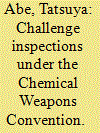

|
|
|
|
|
| Summary/Abstract |
The challenge-inspection system under the 1997 Chemical Weapons Convention has been regarded as an “epoch-making” procedure. Any state party can request a challenge inspection “anytime, anywhere, without right of refusal.” Yet, despite its high value in theory, no challenge inspection has yet been requested. There are legal, political, and other reasons that account for the absence of any such request. However, in the context of Syria's chemical weapons, several ad hoc measures have been taken that could be considered alternative to the challenge-inspection system. These developments have implications, largely negative, for that system. It is likely that ad hoc alternative measures will be employed in the future, though their use will depend on the situation. Although the challenge-inspection system may not be employed in the future, its theoretical availability remains and contributes to the prevention of noncompliance to a certain extent.
|
|
|
|
|
|
|
|
|
|
|
|
|
|
|
|
| 3 |
ID:
156587
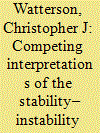

|
|
|
|
|
| Summary/Abstract |
The stability–instability paradox is a well-established concept in the nuclear-security literature, which scholars use to explain sub-strategic militarized conflicts between mutually deterred, nuclear-armed adversaries. Despite its ubiquity, there is a confusion in the literature as to the precise causal mechanism underpinning such conflicts. Competing interpretations of the paradox differ in states' perceptions of nuclear escalatory risk as well as whether the balance of military power or the balance of resolve determines outcomes in these sub-strategic conflicts. Testing their respective explanatory powers in a case study of sub-strategic conflict between nuclear powers—the 1999 Kargil War—demonstrates that these two competing models are mutually exclusive.
|
|
|
|
|
|
|
|
|
|
|
|
|
|
|
|
| 4 |
ID:
156583
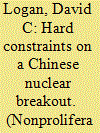

|
|
|
|
|
| Summary/Abstract |
Arguments about China's nuclear-modernization program and its implications for US nuclear policy rest on a fundamental misunderstanding. American experts have resurrected fears of a Chinese nuclear “breakout”—defined here as either development of a nuclear-warfighting capability or a significant and rapid increase in the scale of China's nuclear arsenal—to justify significant changes to US nuclear policies. In addition to the “soft” political constraints on China's nuclear arsenal, Beijing also faces a number of “hard” technical constraints, especially on a “sprint to parity” with the United States and Russia. A Chinese nuclear breakout would require significant changes to China's nuclear infrastructure that are likely to be highly detectable. The United States, while being vigilant for indications of a future Chinese nuclear breakout, should also adopt policies that decrease the likelihood of such changes.
|
|
|
|
|
|
|
|
|
|
|
|
|
|
|
|
| 5 |
ID:
156584
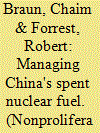

|
|
|
|
|
| Summary/Abstract |
China, as the world leader in constructing new nuclear reactors, has yet to resolve either its short-term spent nuclear fuel (SNF) problems or the challenge of long-term final disposition. While it may be several decades before the fuel disposition question will be resolved, the near-term problem of establishing adequate interim SNF storage is much more acute. The state of nuclear-reactor development in China presents an opportunity to address SNF management issues at an early stage. This article outlines a scenario-based study aiming to inform SNF interim storage policy even while the final disposition solution remains uncertain. We describe a comprehensive model and show results from a crucial subset of issues—the logistics of SNF accumulation, transportation, and storage—and describe simple steps to strengthen the SNF storage system. Finally, we forecast when the current method of SNF disposition could break down and offer recommendations and guidance for further study.
|
|
|
|
|
|
|
|
|
|
|
|
|
|
|
|
| 6 |
ID:
156585


|
|
|
|
|
| Summary/Abstract |
This article analyzes Japan's development of civilian nuclear energy and its potential for developing nuclear weapons in the late 1960s. First, it examines two technological studies of Japan's nuclear fissionable material production capability: one sponsored by the Japanese government and the other sponsored by the US government. A comparative analysis of them reveals that the Japanese study did not investigate the full range of feasible measures toward Japan's nuclear armament. Further scrutiny of Japanese nuclear-energy development in relation to its policy-making structure at that time draws out the following arguments: (1) Japan's civilian nuclear program clearly contributed to its acquisition of a latent nuclear weapon potential; (2) Japan had not deliberately developed the latent capability, which reflected the lack of coordination among political actors; (3) Japan increased its dependence on the United States in the nuclear-power field, making its pursuit of nuclear weapons politically more difficult. This case study of Japan illustrates not only the intricate relationship between the development of civilian nuclear power, the development of nuclear-weapon potential, and the proliferation of nuclear weapons, but also the effects of the state’s nuclear-policy-making structure on its nuclear posture.
|
|
|
|
|
|
|
|
|
|
|
|
|
|
|
|
| 7 |
ID:
156588


|
|
|
|
|
| Summary/Abstract |
Some scholars have suggested that illicit state-to-state technology transfer and black-market activities are the primary vectors by which technically weak states acquire nuclear weapons. However, a more recent literature has questioned this view, arguing that natural technological change and public-domain information have been potentially more important enablers of proliferation. Articles supporting this perspective have examined gas centrifuge programs in emerging nuclear powers and failed proliferators. This article examines how viable centrifuge-engineering information first circulated and eventually entered the public domain. It then traces the adoption of this technology in nine latent proliferators: countries that are not known to have pursued nuclear weapons immediately, but which nonetheless became capable of making them. The histories of these programs reinforce the argument that public-domain information and basic technology are adequate for proliferation and cannot be reliably limited by technology controls or secrecy.
|
|
|
|
|
|
|
|
|
|
|
|
|
|
|
|
| 8 |
ID:
156590


|
|
|
|
|
| Summary/Abstract |
Since 1995, unsuccessful efforts to promote a Middle East weapons-of-mass-destruction-free zone (MEWMDFZ) within the review process of the Treaty on the Non-Proliferation of Nuclear Weapons (NPT) have weakened the treaty regime. This viewpoint proposes establishing a designated Middle East Support Unit to work independently from and in parallel to the NPT review process. The Support Unit will contribute to both global and regional security. Globally, its work will increase the ability to reach a consensus-based final document at the 2020 NPT Review Conference, which in turn will strengthen support for the treaty. Regionally, the Support Unit can help reinvigorate dialogue on security measures and nonproliferation in the Middle East. The possibility of resuming a direct dialogue between states in the region is of utmost importance today, as growing regional instability is a source of mutual concern to the Arab states, Iran, and Israel.
|
|
|
|
|
|
|
|
|
|
|
|
|
|
|
|
| 9 |
ID:
156586
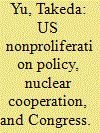

|
|
|
|
|
| Summary/Abstract |
The 1988 revision of the US–Japan Nuclear Cooperation Agreement offers a major precedent both for current US nuclear cooperation policy and for the role played by Congress. Drawing on the Congressional Record and other primary sources, this article examines how US legislators criticized the agreement, forcing the Ronald Reagan administration to alter the subsequent arrangement and abandon the original idea of transporting plutonium by air. Congressional opponents could not prevent the adoption of the agreement outright, partly because of Japan's strong nonproliferation credentials, which helped to allay proliferation concerns. Instead, they focused their concerns on Japan's use of plutonium. By exploiting a split in the administration and stirring environmental concerns over air transportation of plutonium from Europe to Japan, opponents succeeded in affecting the outcome of the agreement. With the agreement up for automatic renewal in July 2018, current congressional concerns over Japan's excess plutonium stocks may play a similar influential role.
|
|
|
|
|
|
|
|
|
|
|
|
|
|
|
|
|
|
|
|
|